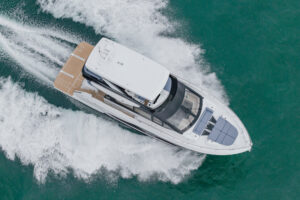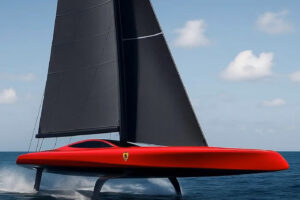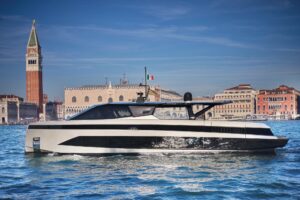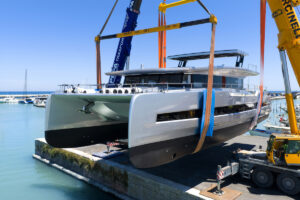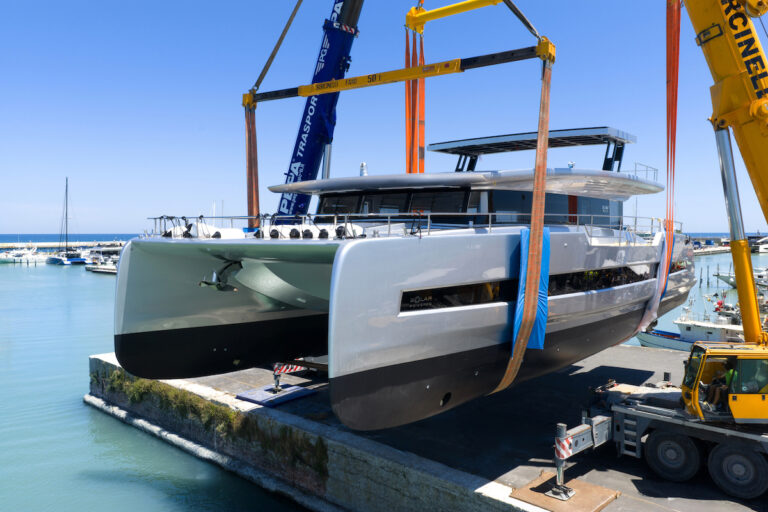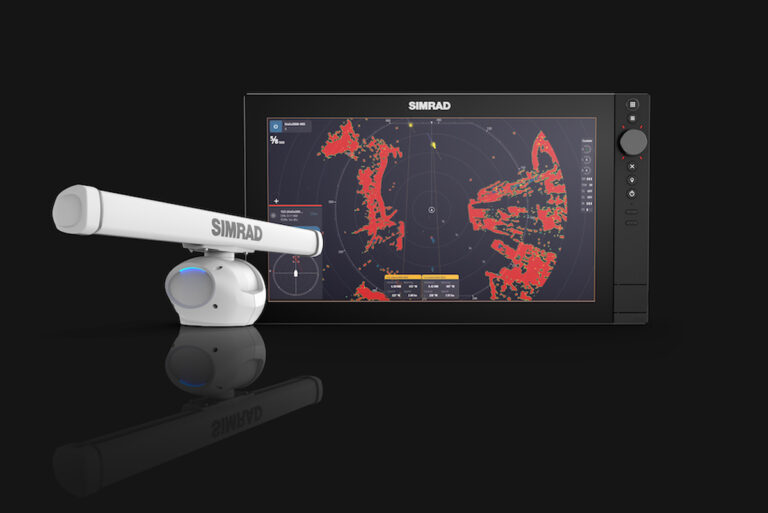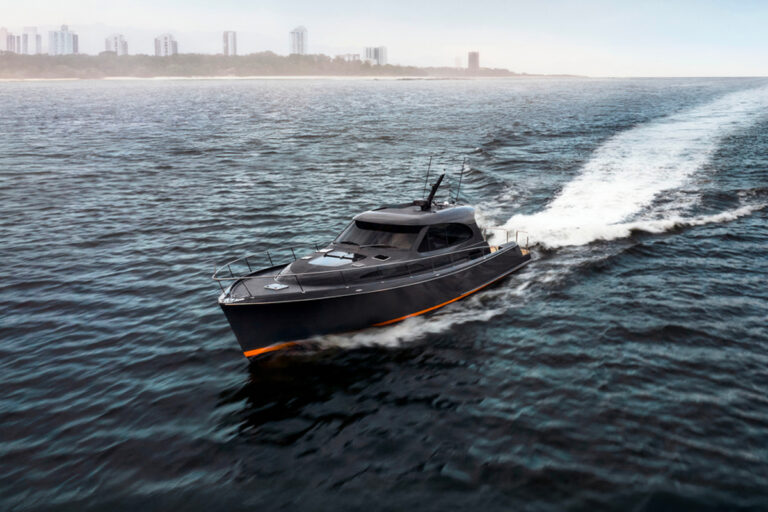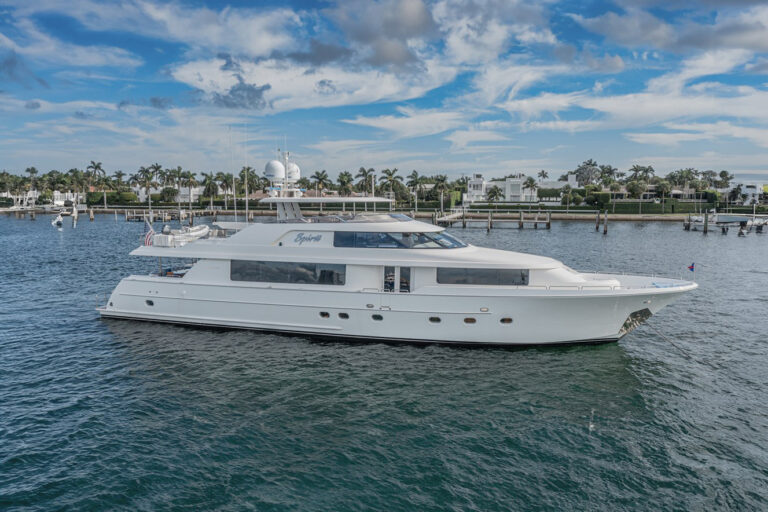
Speed is a relative thing. Streaking across the sky at 600 knots in an airliner seems like nothing, while running along the sea at 40 knots on a 113-ton, 108-foot yacht seems incredibly quick. When looking astern, one doesn’t see a wake; instead, massive fire-hose blasts exit the three water jets.
But that’s not the only surprising thing about the Sanlorenzo SP110 (SP for smart performance). With exterior lines from Studio Zuccon International Project, interior design by Piero Lissoni and a hull form from Marco Arnaboldi, this group literally turned everything around.
Many yachts have an atrium, using the slanted windshield to create an open forward entry to the lower staterooms. On the Sanlorenzo, the atrium is aft, with a double-height space that provides ocean vistas from the upper salon as well as a lower “den” with loft-like space. This den opens directly to the corridor leading to the four staterooms, so guests can mosey from their staterooms directly into this space overlooking the aft deck, perhaps to enjoy morning espresso and croissants. Then, they can ascend a floating stairway that underlines the airy feel of this yacht.

The staterooms all open off a central corridor from the den, with a choice of three or four. Two en suite double staterooms are aft on each side, with the master at the forward end of the companionway. A fourth stateroom, opposite the starboard-side master, can be an extension of the master. Sanlorenzo calls this fourth space a “jolly room.” It could provide owners with their own getaway with a couch or a desk. Placing the master head forward provides a natural sound barrier between crew and guest spaces.
Sanlorenzo calls the SP110 its first “open coupe.” The low, lean looks certainly support that description, so the two levels are a surprise. The main deck—or salon level—has an entertainment area aft with loose chairs and a 12-foot-long settee, while the formal dining area has a 6-by-6-foot aluminum table with room for eight guests. Sliding doors on each side combine with lowered bulwarks outside to create the essence of alfresco dining while remaining protected from the elements.
The galley serves as a subtle divider between guests and crew, spanning the beam just forward of the salon and effectively separating the pilothouse, where a single pedestal chair and a small settee add to a professional layout with a flat-black dash and twin monitors. This area also provides access to the three en suite crew cabins.

This yacht’s nearly invisible flybridge is pure sun pad, and it’s set well aft with a vestigial helm to allow for the cabin top to be covered in solar panels that feed lithium batteries to run the hotel functions without requiring use of the two (35 kW and 28 kW) gensets. In sunny areas, Sanlorenzo says, the 60 kW produced daily will run the hotel load for up to four hours.
Foredeck sun pads convert to an alfresco dining area, a break from the usual cockpit dining and a way to create privacy when Med-moored to a quay. The anchor is cleverly handled by an Arnaboldi-designed folding-bow section that opens upward like a walrus snout to hide, hold and manage the anchor and chain.
Aft, the considerable deck space (500-plus square feet) has more sun pads, and the entire transom folds down to create steps leading to a “beach.”

Power for the SP110 is a trio of 2,000 hp MAN V-12 diesels paired with three Marine Jet Power water jets, with the center jet used as a booster for top speed. This setup allows the captain to dial in one, two or all three engines, depending on the speed desired and the fuel usage tolerated.
During my time aboard, we had all three jets online, and the SP110 easily hit 36.3 knots while burning about 290 gallons per hour in the lumpy Gulf Stream. Range at this top hop is about 385 nautical miles. The builder reports seeing 40 knots in calmer conditions. Of particular note is that the salon had a sound level of just 62 decibels, similar to a quiet refrigerator or a normal conversation. We didn’t have a chance to run on fewer engines, but Sanlorenzo says that at 10 knots, with the two outboard engines at 800 to 900 rpm, the fuel consumption drops to just about 30 gph, and range jumps to 1,000-plus nm. At 2,000 rpm, cruise speed is 27 knots while the trio of diesels consume 189 gph, resulting in a range of 433 nm.
The day proved the efficiency of the double-chined hull with large flats, which both threw spray far away and added interior space in the 27-foot beam. With proprietary hybrid carbon-composite construction, the Sanlorenzo SP110 was free of any creaks or groans, and had a solid feel in all seas.
This is a yacht that truly challenges many preconceived notions about what a luxury performance yacht can be.

The Hidden Tender
A 15-foot Williams jet tender is concealed under three lifting hatches in the SP110’s cockpit with a folding crane that resembles a football goal post. An even larger tender can be deck-chocked, along with personal watercraft.
Hydro Power
Built for strength from a duplex stainless-steel structure, the Marine Jet Power CSU550 water jets on the SP110 are reportedly stronger and more corrosion-resistant for less maintenance. The Swedish company has a reputation for yacht, commercial and military uses, and the 550 enables speeds of more than 50 knots as well as sideways, spinning and reverse precision, plus GPS positioning.
Meet the Designer
Italian naval engineer Marco Arnaboldi is known as a speed merchant, having penned many of the fast AB Yachts, high-speed Azimuts like the 103SL and designs for Viareggio Super Yachts. The SP110 shows his penchant for long, slippery, higher-performance hulls.
Take the next step: americas.sanlorenzoyacht.com

